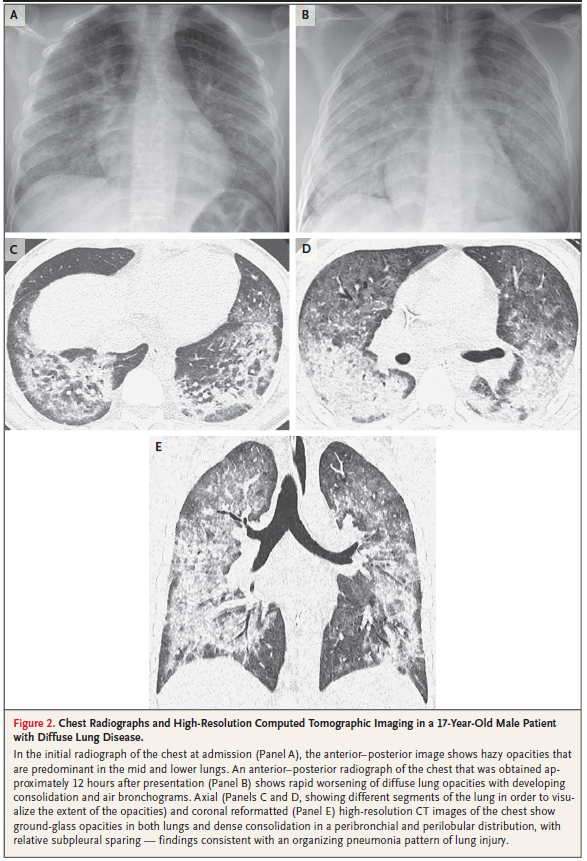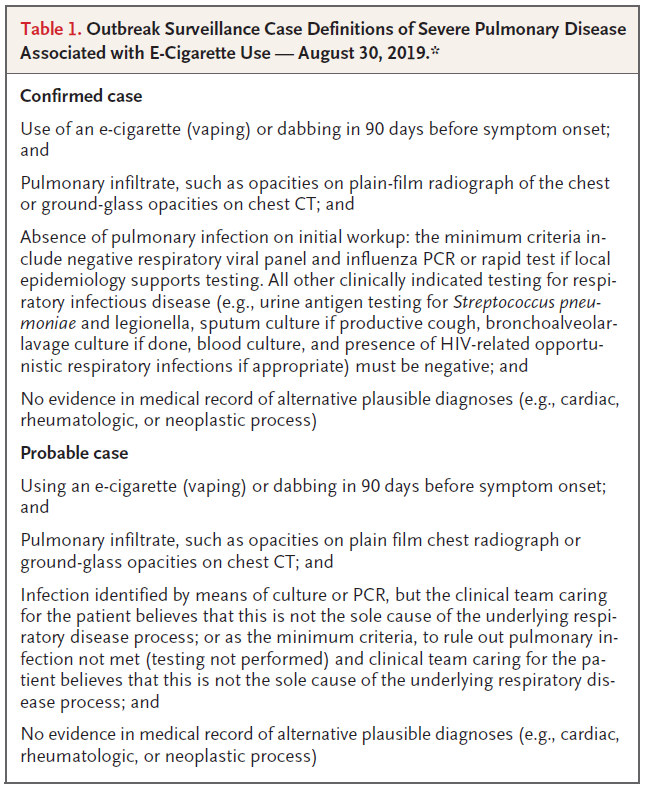
The CDC has reported 1080 cases of Vaping Associated Pulmonary Injury (VAPI) and 18 deaths so far and that number is only going to increase. As of 2017, 2 million middle school and high school kids were using e-cigarettes. Its not a matter of if but when we will start seeing VAPI in adolescents. Like Thanos, it is inevitable.
This PEM to the POINT will discuss what e-cigarettes are, the pathophysiology of VAPI, and how we as providers can diagnose this 21st century disease.
What is Vaping?
Besides fooling me into thinking there is cotton candy near by, vaping is the use of an electronic, batter powered cigarette that aresolizes nicotine, THC, cannabidiol, or hash oils. It has now become the most commonly used tobacco product with a prevalence of ~21% among high school students compared to cigarette use of 3.2%. Different flavors are offered and generally are marketed towards a younger audience. Luckily, states are starting to enact policy to make it more difficult to obtain these but it will undoubtedly still be a problem.

What is VAPI?
VAPI a vaping induced lung injury that is leading to significant respiratory distress and can be severe enough to cause respiratory failure. Lipid-laden macrophages have been a consistent finding in multiple cases of VAPI but it is still unclear as to the definitive cause of injury. There is a new thought that Vitamin E (used to carry THC) is a primarily culprit in the development of injury although this has not been proven.
What Should I Be Looking For?
The CDC has come out with a surveillance definition (XR findings of lung injury with a history of e-cigarette/vaping product within the previous 90 days and no alternative diagnosis) and if patient meet the requirements, should be reported. Diagnosis of VAPI is difficult. An essential factor is having a high index of suspicion.
Clinical Presentation
Respiratory symptoms
Shortness of breath
Cough
Less commonly: hemoptysis, chest pain.
GI Symptoms
Nausea
Vomiting
Less commonly: abdominal pain, diarrhea
Constitutional Symptoms
Fevers
Chills
Less commonly: chills, weight loss, headaches, fatigue
Dr. Shan Yin Medical Director, Drug and Poison Information Center states:
– Nearly all of the cases had some element of GI symptomatology and a few presented without any respiratory symptoms
– 70% of the cases presented with saturations <94%
Laboratory Findings
Leukocytosis >11,000 with neutrophil predominance
ESR >30mm/hr
Less commonly: hyponatremia, hypokalemia
Imaging Findings
CT Scan abnormalities were found on 100% of patients: bilateral infiltrates with ground glass appearance

Image taken from Layden J, Ghinai I, Pray I, et al. Pulmonary illness related to e-cigarette use in Illinois and Wisconsin—preliminary report. N Engl J Med 2019. 10.1056/NEJMoa1911614
How to Treat It?
This is an inpatient disease with most requiring ICU level care. Many VAPI patients require intubation and mechanical ventilation with case reports of patients requiring ECMO.
Although there are no definitive management recommendations, most patients end up receiving empiric antibiotics. The CDC recommends giving steroids as there has been improvement. In the emergency department, the most important treatment is to protect the ABC’s. These patients are frequently requiring intubation and significant respiratory support.

1. Keep an eye out for patients with vague respiratory symptoms (cough, shortness of breath) without other signs of infection
2. Dr. Yin Recommendations
– All adolescents with radiologically positive diagnosis of pneumonia be questioned about e-cigarette or vaping
– Any adolescent with GI symptoms of >5-7 days being questioned about e-cigarette or vaping and consider a CXR
3. Have a high index of suspicion. If you don’t ask your patient, you will never know.
4. If they meet the criteria for surveillance (below), go to this CDC link to find out how to report. (These are surveillance criteria, not diagnostic)

References
Viswam D, Trotter S, Burge PS, Walters GI. Respiratory failure caused by lipoid pneumonia from vaping e-cigarettes. BMJ Case Rep 2018; 2018: 224350.
Cullen KA, Ambrose BK, Gentzke AS, Apelberg BJ, Jamal A, King BA. Notes from the field: use of electronic cigarettes and any tobacco product among middle and high school students — United States, 2011–2018. MMWR Morb Mortal Wkly Rep 2018; 67: 1276-
Layden J, Ghinai I, Pray I, et al. Pulmonary illness related to e-cigarette use in Illinois and Wisconsin—preliminary report. N Engl J Med 2019. 10.1056/NEJMoa1911614
Schier JG, Meiman JG, Layden J, et al. Severe Pulmonary Disease Associated with Electronic-Cigarette–Product Use — Interim Guidance. MMWR Morb Mortal Wkly Rep 2019;68:787–790. DOI: http://dx.doi.org/10.15585/mmwr.mm6836e2external
CDC Recommendations for Health Care Providers. https://www.cdc.gov/tobacco/basic_information/e-cigarettes/severe-lung-disease/healthcare-providers/index.html

Ashish Shah is an assistant professor and Pediatrics and Family Medicine Residency Education Director at Rady Children’s Hospital interested in creating PEM 4 all stages of learners caring for children seen in the emergency department


